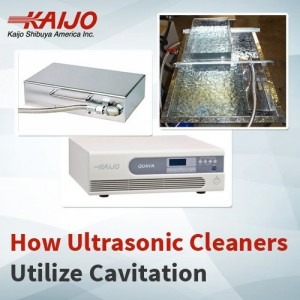How Ultrasonic Cleaners Utilize Cavitation
May 17, 2017
 Ultrasonic cleaning systems use cavitation in cleaning liquids to remove contaminants and surface dirt from a wide variety of parts that need cleaning. Cavitation bubbles are created by the action of sound waves in a cleaning solution. As the ultrasonic sound waves travel through the liquid, bubbles appear in the low-pressure troughs of the waves and collapse in the high-pressure peaks. The creation and collapse of the bubbles results in a powerful scrubbing action that operates throughout the liquid.
Ultrasonic cleaning systems use cavitation in cleaning liquids to remove contaminants and surface dirt from a wide variety of parts that need cleaning. Cavitation bubbles are created by the action of sound waves in a cleaning solution. As the ultrasonic sound waves travel through the liquid, bubbles appear in the low-pressure troughs of the waves and collapse in the high-pressure peaks. The creation and collapse of the bubbles results in a powerful scrubbing action that operates throughout the liquid.
Manufacturing plants that have equipment cleaning needs can benefit from the fast, thorough cleaning provided by industrial ultrasonic cleaners. Parts such as nozzles, containers, valves and tools can often be cleaned completely in as little as ten minutes. Manufacturers of parts or finished products can use ultrasonic cleaners to remove process material before shipping or clean products such as medical devices, solar cells, jewelry and ceramics. Ultrasonic cleaners work quickly and effectively without harsh chemicals.
How to Get the Cleaning Action You Need
The action of the cavitation bubbles can be adjusted by varying the ultrasonic frequency and the cleaning power. At low frequencies such as 26 kHz to 38 kHz, the ultrasonic wave peaks and troughs are comparatively far apart, resulting in larger bubbles. When large bubbles are created and collapsed, the scrubbing action is comparatively intense. Such low frequencies can clean rugged parts with stubborn dirt rapidly but they are not suitable for more delicate parts or parts with soft surfaces where the large bubbles may cause pitting or other damage.
Intermediate frequencies such as 78 kHz to 160 kHz result in smaller bubbles and less aggressive cleaning. Systems operating at these intermediate frequencies can clean fragile machined parts and soft materials. Even higher frequencies such as 1 MHz and above deliver very gentle cleaning action and are suitable for cleaning delicate semiconductor devices and microscopic structures. Customers can select either a single-frequency cleaner suitable for a clearly defined cleaning task or cleaning systems that can operate at several frequencies to deliver the level of cleaning action required for different cleaning applications.
Depending on the size of the parts to be cleaned, the power of the ultrasonic cleaning system must be high enough to generate bubbles throughout the cleaning tank. A single ultrasonic transducer array can deliver power of up to 1200 W and clean parts up to about 500 mm (20 inches) long. For larger parts needing bigger tanks, several ultrasonic transducers can be mounted along the bottom or on the sides. A custom design for such applications can use existing or new tanks to match customer needs.
Benefits of Kaijo’s Ultrasonic Cleaning Systems
Kaijo offers a complete line of industrial ultrasonic cleaners. Turn-key systems such as the Phenix III include an ultrasonic generator and a tank with the transducers already mounted. These systems are ready to start cleaning with a minimum of installation and setting up.
Alternatively customers can opt to buy ultrasonic generators such as the Quava or Phenix Series and buy transducers and tanks separately. These are excellent options for applications where existing cleaning tanks are to be re-used and Kaijo can help with such customizations.
Benefits of using these systems for industrial cleaning applications include the following:
- Quick and complete cleaning of all types of parts to remove a variety of contaminants
- Effective cleaning of complex shapes and parts with holes and crevices
- Cleaning without harsh chemicals or mechanical scrubbing
- The safe, efficient cleaning process results in improved facility performance and better quality output
Kaijo can advise customers on how to best satisfy their cleaning requirements and help them select the system they need. The company’s experience and expertise help ensure that the ultrasonic cleaners meet and exceed expectations. If you would like a quote or free consultation on how industrial ultrasonic cleaners can be used for your cleaning application call Kaijo or email info@kaijo-shibuya.com.





